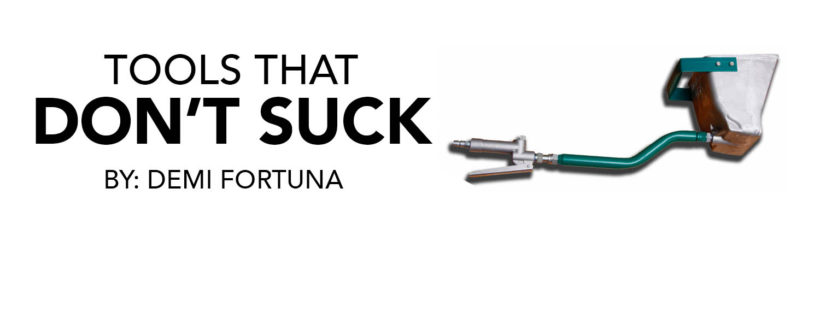As water feature installers, my sons and I are used to hard, dirty, sometimes dangerous work. We enjoy what we do, whether it’s digging ponds, plumbing pumps, rolling boulders or tweaking waterfalls, but we also value anything that helps make the work easier or more fun. We’re always looking for tools, apps or gadgets that save time & effort, eliminate stress, add to our comfort on the job or are just fun to use. Often a buddy will turn us on to one. I’d like to return the favor by passing our favorite Tools That Don’t Suck along to you.
Tirolessa Sprayer
Every now and then a tool comes along that does a job simply and inexpensively, that otherwise would have required a major investment in time, energy and equipment. Typically, these tools are born of necessity, because someone, somewhere doesn’t have access to the technology – or the money – to get the job done any other way. Today’s entry in the TTDS category is that kind of tool.
I ran across the Tirolessa sprayer online a dozen years ago when I was investigating building a dome home. I had this idea about an ecotourism bed-and-breakfast in the mountains of Michoacan, Mexico, where the Monarch butterflies go on their amazing winter migration. I figured I could create really cool, inexpensive and energy-efficient housing modules by covering an inflatable mold with multiple thin layers of fiber-reinforced concrete, building up the layers successively until the structure was strong enough to resist not only weather, but earthquakes too. The trick is to get a thin, strong first layer of concrete without deforming or collapsing the plastic balloon form. After the layers are self-supporting, the form is deflated and the rest of the concrete dome built up by troweling. The Tirolessa sprayer was recommended as the ideal tool to apply those first thin layers.
Well, just about the same time as I was pipe dreaming, I was asked to build caves and huge artificial boulders around a 200-foot-wide pond cover an interior wall with waterfalls. I had just finished plumbing and tweaking a Hawaiian-themed “black lava” waterfall in a restaurant. A Gunite crew had been called in to form the structure out of rebar covered with wire lathe and shot the whole wall with very wet black cement. I bought the Tirolessa thinking it might replace the Gunite crew – and it did. I wasn’t very good at texturing the final product, but there was no doubt about it. This little gadget could really blow some mud.
Yes, blow. The Tirolessa is basically a stainless steel bucket with air holes at the bottom. The handle is a hollow steel tube to which an airhose is attached, with a trigger. Pull the trigger and air blows inside the bucket across the bottom and out the front-facing air holes, carrying a spray of very loose concrete slurry with it. We make a mix of two parts fine sand to one part Portland cement, with enough water to give it a consistency between pea soup and oatmeal. Scoop a bucket of slurry from the wheelbarrow, hold the bucket two feet from the vertical surface to be covered, pull the trigger and spray the slurry. And repeat.
We’ve found the Tirolessa invaluable for getting that first critical layer on difficult vertical surfaces, and that has opened a whole new range of possibilities for us. Now we can easily protect the inside of any EPDM pond without building inner walls. The Tirolessa still can’t make concrete stick to rubber, but it CAN make cement stick to vertical geotextile, no problem at all. We cover our vertical liner walls with a layer of geotextile, well-anchored at the top so it will support the weight of the cement we spray on it until the first layer dries. If needed, we spray another layer on that until the curtain of concrete-covered fabric is stiff enough, then we switch to troweling on additional layers, this time with chopped polypropylene fibers mixed in.
By the time we have 4 to 5 thin layers, around an inch and a half thick, the skin will withstand a blow from a sledge hammer. We often add powdered black dye to the last coat so the finished pond appears bottomless; it also enhances the colors of koi. And it all starts with one of my favorite Tools That Don’t Suck, the Tirolessa sprayer.



